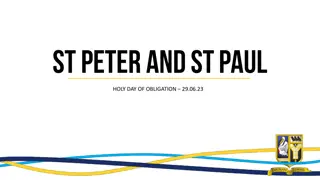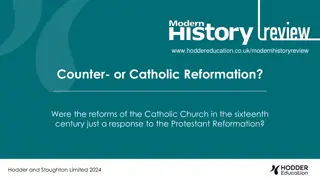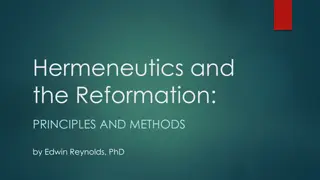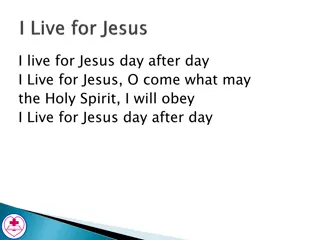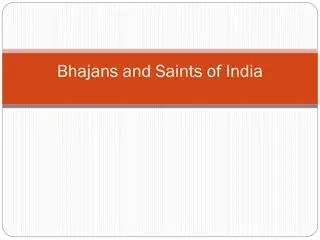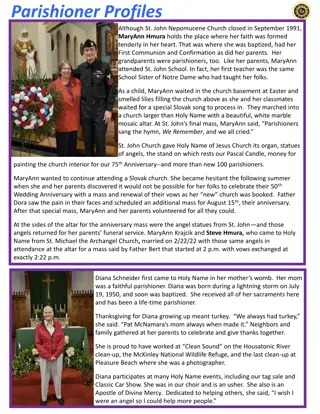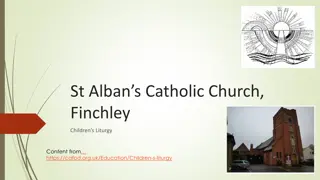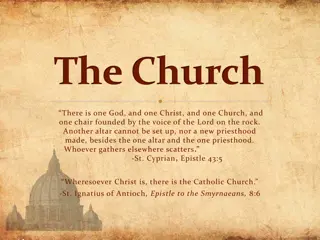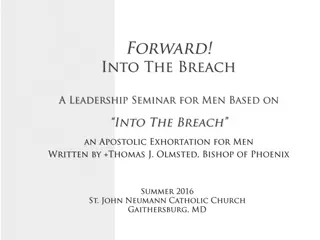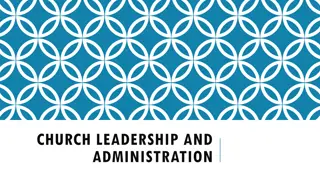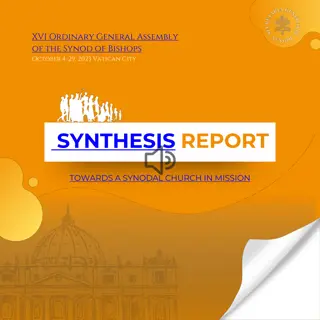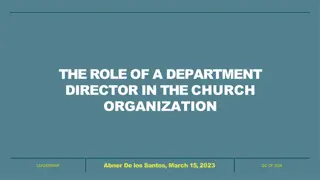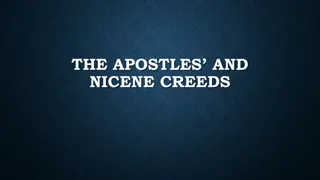Black Saints of the Catholic Church: Inspirational Stories of Faith and Devotion
Explore the lives of Black saints in the Catholic Church, such as St. Alphonsus Liguori, St. Katharine Drexel, and St. Antony of Egypt, who dedicated their lives to spiritual growth, service to the poor, and devotion to God. Learn about their remarkable journeys and the impact they had on the Church and society.
Download Presentation

Please find below an Image/Link to download the presentation.
The content on the website is provided AS IS for your information and personal use only. It may not be sold, licensed, or shared on other websites without obtaining consent from the author. Download presentation by click this link. If you encounter any issues during the download, it is possible that the publisher has removed the file from their server.
E N D
Presentation Transcript
BLACK SAINTS OF THE CATHOLIC CHURCH St Alphonsus Liguori Rock Church November 2020 Black Catholic History Month
Black St Anthony of Egypt St Fulgentius St Anthony of Thebes St Josephine Bakhita Saints of St Antonio Vieira St Katharine Drexel* St Athanasius St Martin de Porres St Augustine of Hippo St Mary of Egypt St Benedict the Black St Maurice the St Bessarion St Moses the Black St Catherine of Alexandria St Pachomius St Charles Lwanga St Peter Claver* St Crispina St Thecla Catholic Church St Cyril of Alexandria St Zeno St Cyprian Sts Perpetua & Felicity St Frumentius * Not of African descent
St Anthony of Egypt St. Anthony of Egypt is also known as St. Anthony the Abbot, St. Anthony the Great and the "Father of All Monks." His life is similar to that of St. Francis of Assisi. At 20, he was so moved by the Gospel message, "Go, sell what you have, and give to (the) poor" (Mark 10:21b), that he actually did just that with his large inheritance. He is different from Francis in that most of his life was spent in solitude. He saw the world completely covered with snares and gave the Church and the world the witness of solitary asceticism, great personal mortification and prayer. But no saint is anti-social and Anthony drew many people to himself for spiritual healing and guidance. At 54, he responded to many requests and founded a sort of monastery of scattered cells. While he was not the first desert monk or hermit, the biography of his life by St. Athanasius of Alexandria later helped to spread the concept of monasticism, particularly in Western Europe through Latin translations. At 60, he hoped to be a martyr in the renewed Roman persecution of 311, fearlessly exposing himself to danger while giving moral and material support to those in prison. At 88, he also fought against the heresy of Arianism. He is often depicted with a Tau-shaped cross, a pig and a bell. In the Middle Ages the belief arose that praying to St. Anthony would effect a cure for ergotism, a type of skin inflammation now also called "St. Anthony's fire." An order devoted to caring for those afflicted with the disease, the Order of Hospitallers of St. Anthony of Egypt, wore the Tau cross and rang bells to beg for alms, and pigs belonging to the order were allowed to roam the streets freely. St Anthony is the patron saint of animals, skin diseases, farmers, butchers, basket makers, brush makers, grave diggers, Pontifical Ecclesiastical Academy, Rome. Attributes: bell, pig, book, Tau cross and Tau cross with bell pendant. He died in 356 in solitude at the age of 105, and his feast day is Jan. 17. Reflection: Have I spent any alone-time in prayer today?
St. Anthony the Great of Thebes St. Anthony is called the Patriarch of Monks. He was born at Aama, a village south of Memphis, near Thebes. His parents were rich Christians. Shortly after inheriting his parents' fortune, he sold all his vast fortune and gave the proceeds to the poor, sent his sister to a convent and retired to an old ruin of a tomb. He ate only every three or four days and spent his time at manual labor and prayer. He is the patron saint of herdsmen. Attributes: pig and halo. The memorial day of St. Anthony is celebrated on January 17. Reflection: Have I offered any help to the poor and most abandoned?
St. Antonio Vieira Antonio Vieira was an African born in Portugal. When he was fifteen years old, he became a Jesuit novice and later a professor of rhetoric and dogmatic theology. He went to Brazil where he worked to abolish discrimination against Jewish merchants, to abolish slavery, and to alleviate conditions among the poor. On the 200th anniversary of his death in 1897, he was canonized. Reflection: Do I speak up against anti- Semitism and Islamophobia?
ST. ATHANASIUS St. Athanasius, the great champion of the faith and Doctor of the Church, was born in Alexandria about the year 296, of Christian parents. Educated under the eye of Alexander, later bishop of his native city, he made great progress in learning and virtue. In 313, Alexander succeeded Achillas in the Patriarchal See, and two years later St. Athanasius went to the desert to spend some time in retreat with St. Anthony of Egypt (of whom he later wrote a biography that popularized monastic life). In 319, he became a deacon and was called upon to oppose the rising heresy of Arianism, which was to become his life's struggle. In 325, he assisted Bishop Alexander at the Council of Nicaea, where the Nicene Creed was formulated and the dual nature of Christ as both God and man was affirmed. Five months later Bishop Alexander died, and on his death bed he recommended St. Athanasius as his successor. Athanasius was unanimously elected patriarch in 326. His refusal to tolerate the Arian heresy was the cause of many trials and persecutions for him. He spent 17 of the 46 years of his episcopate in exile. After a life of virtue and suffering, this intrepid champion of the Catholic faith died in peace on May 2, 373. Attributes: Bishop arguing with a pagan, holding an open book, standing over a defeated heretic.
ST. AUGUSTINE OF HIPPO St. Augustine's complete turnaround and conversion from a life of loose living and ambition has been an inspiration to many who struggle with a particular vice they long to break. This famous son of St. Monica was born in Africa and spent many years of his life in wicked living and false beliefs. Though he was one of the most intelligent men who ever lived and though he had been brought up a Christian, his sins of impurity and his pride darkened his mind so much that he could not see or understand the Divine Truth anymore. Through the prayers of his holy mother and the powerful preaching of St. Ambrose, Augustine finally became convinced that Christianity was the one true religion. Yet he did not become a Christian then, because he thought he could never live a pure life. One day, however, he heard about two men who had suddenly been converted on reading the life of St. Anthony, and he felt ashamed. "What are we doing?" he cried to his friend Alipius. "Unlearned people are taking Heaven by force, while we, with all our knowledge, are so cowardly that we keep rolling around in the mud of our sins!" Full of sorrow, he flung himself out into the garden and cried out to God, "How long more, O Lord? Why does not this hour put an end to my sins?" Just then he heard a child singing, "Take up and read!" Thinking that God intended him to hear those words, he picked up the book, the Letters of St. Paul, and read the first passage he saw. It was just what Augustine needed, for in it, St. Paul says to put away all impurity and to live in imitation of Jesus. From then on, he began a new life. He was baptized, became a priest, bishop, writer, theologian and one of the greatest saints who has ever lived. He recounted his remarkable conversion story in "The Confessions," the most intimate and well-known glimpse into a person's soul ever written. Besides seminal writings on the Trinity, Christian piety and Catholic doctrine, he also wrote "The City of God" to refute allegations that Christianity caused the decline of the Roman empire. St. Augustine overcame strong heresies, practiced great poverty and supported the poor, preached very often and prayed with great fervor right up until his death in 430. "Too late have I loved You!" he once cried to God, but with his holy life he certainly made up for the sins he committed before his conversion. He was one of the most significant and influential thinkers in the history of the Church, and his teachings were the foundation of Catholic doctrine for a millennium. He is the patron saint of brewers, printers, theologians and a number of cities and dioceses. He is invoked against sore eyes. Forever linked to his persistent mother St. Monica, his feast day is one day after hers: Aug. 28.
ST. BENEDICT THE MOOR St. Benedict the Moor (also called Benedict the Black), a lay brother, was born in Sicily in 1526. He was the son of African slave parents, but he was freed at an early age. When he was about 21, he was insulted because of his color, but his patient and dignified bearing caused a group of Franciscan hermits who witnessed the incident to invite him to join their group. He became their leader. In 1564 he joined the Franciscan friary in Palermo and worked in the kitchen until 1578, when he was chosen superior of the group. He was known for his power to read people's minds and held the nickname of the "Holy Moor." His life of austerity resembled that of St. Francis of Assisi. He is the patron saint of African missions, African Americans, Black missions, Black people and Palermo. His feast day is April 4. Reflection: How many random acts of kindness have I performed today?
ST. BESSARION (also BESSARIAN) Bessarion was a native of Egypt and, having heard the call to perfection, he went into the wilderness, where he was a disciple first of St. Antony and then of St. Macarius. Rather than live under a roof he wandered about like a bird, observing silence and subduing his flesh by mighty fasting. His neighborly charity led him to a height of perfection that was manifested by miracles: he made saltwater fresh, he several times brought rain during drought, he walked on the Nile, he overcame demons. Like so many other desert fathers, St. Bessarion lived to a great age; and he was compared by his admirers with Moses, Joshua, Elias, and John the Baptist. St. Bessarion is named in the Roman Martyrology on June 17th, but his usual date in the East is June 6th. Reflection: Do I spend any quiet time in prayer and fasting?
ST. CATHERINE OF ALEXANDRIA She was born in 287 in Alexandria, Egypt, waseducated and of noble birth, possibly a princess. Around the age of fourteen, she experienced a moving vision of Mary and the infant Jesus, and she decided to become a Christian. Although she was a teenager, she was very intelligent and gifted. At age eighteen shepresented herself to the Roman emperor Maxentius, confronted him for his cruelty to Christians and outwitted him in the debate about worshipping false gods. Rather than order her execution, Maxentius summoned fifty orators and philosophers to debate her. However, Catherine was moved by the power of the Holy Spirit and spoke eloquently in defense of her faith. Her words were so moving that several of the pagans converted to Christianity and were immediately executed. Catherine herself was condemned to die by being stretched on the wheel, but her touch rendered the tortuous devise useless. The Emperor, enraged beyond control, then had her beheaded in 306. She is the patron of a great many professions and causes. Her patronage includes students, unmarried girls, apologists and many more as well as many places around the world. Her feast day is Nov. 25. Reflection: Is there a way that I am being called to speak truth to power?
ST. CHARLES LWANGA AND COMPANIONS The Society of Missionaries of Africa (known as the White Fathers) had been in Uganda for only six years but had built up a community of converts who were soon gaining new converts themselves. Many of these converts lived and taught at the royal court, where the violent ruler and pedophile King Mwanga routinely forced himself on the young boys and men who served him as pages and attendants. Led by the king's chief steward, 25-year-old Joseph Mkasa, the Christians among the king's court tried to protect the younger boys. When the king killed a Protestant missionary and his companions, Mkasa confronted Mwanga. The king struck him with a spear and ordered him killed. When the executioners tried to tie his hands, he told them, "A Christian who gives his life for God is not afraid to die." He forgave Mwanga before being beheaded and then burned on Nov. 15, 1885. After other Christians were martyred by the king, Charles Lwanga took over instructing the young Christian community and the charge of keeping the boys and men away from the king. When the king learned that another page was being taught the faith, he thrust a spear through the young man's throat and sealed the royal compound. Knowing what was coming, Lwanga baptized four catechumens that night. The next morning Mwanga separated the Christians from the rest, saying, "Those who do not pray stand by me, those who do pray stand over there." He demanded of the 15 boys and young men (all under 25) if they were Christians and intended to remain Christians. When they answered "yes," he condemned them to death. They were marched 37 miles to Namugongo, where those who were not killed along the way were burned to death on June 3, 1886. The White Fathers were expelled from Uganda, but when they returned after Mwanga's death, they found 500 Christians and 1,000 catechumens waiting for them.
ST. CRISPINA St. Crispina was held in high veneration all through Africa and was honored by St Augustine in various parts of his works, in which he speaks of her martyrdom. He especially praised her allegiance to God above material goods. She was a noble lady, a wealthy Roman wife and the mother of several children. When she found herself in danger of losing her children, her possessions, and her life, in the persecution which was then raging; instead of being intimidated, she was filled with a holy joy, not unworthy of the Christian education which she had received from her most tender years. Being arrested in her native city of Thagara by order of the proconsul Anulinus, and brought before his tribunal, he inquired of her whether she was aware of the imperial edicts which commanded that all persons should sacrifice to the gods of the empire. St. Crispina replied, I have never sacrificed, nor will I sacrifice to any other than to one God, and to our Lord, Jesus Christ His Son, who was born and suffered for us. Anulinus then said, Leave this thy superstition, and adore the gods. Every day, said St Crispina, I adore my God and besides Him I know of no others. Crispina continued in her refusal to deny Christ and was tortured, publicly ridiculed and then beheaded. Reflection: How much value do I put on my material possessions?
ST. CYPRIAN St. Cyprian of Carthage is second in importance only to St. Augustine as a figure and Father of the African Church. He was born to wealthy pagans around the year 190 and was educated in the classics. Like St. Augustine after him, he questioned what truth was and searched for it in practicing law and rhetoric. He was curious about Christianity, and after much study he converted at the age of 56. He sold all his property and was ordained a priest a year later, and bishop two years after that. His writings are of great importance, especially his treatise on "The Unity of the Catholic Church," in which he argues that unity is grounded in the authority of the bishop, and among the bishops, in the primacy of the See of Rome. In it, he wrote, "You cannot have God for your Father if you do not have the Church for your mother.... God is one and Christ is one, and His Church is one; one is the faith, and one is the people cemented together by harmony into the strong unity of a body.... If we are the heirs of Christ, let us abide in the peace of Christ; if we are the sons of God, let us be lovers of peace." He was martyred on Sept. 14, 258.
ST. CYRIL OF ALEXANDRIA St. Cyril of Alexandria, Doctor of the Church, is best known for his role in the Council of Ephesus, where the Church confirmed that Christ is both God and man in one Person. He was born in Alexandria between 370 and 380, the nephew of the patriarch of that city, Theophilus. He received a classical and theological education and was ordained by his uncle. He succeeded his uncle as patriarch of Alexandria in 412, but only after a riot between his supporters and the followers of a rival. In 430 he became embroiled with Nestorius, patriarch of Constantinople, who was preaching that Mary was not the Mother of God but only the mother of Christ the man thereby denying Christ's dual nature as both human and divine. He persuaded Pope Celestine I to convoke an ecumenical council at Rome from June 22 to July 31, 431. It was a tumultuous affair, with rival prelates from Constantinople and Alexandria and their advocates sometimes getting physically violent. But Cyril brilliantly defended the orthodox belief in Christ as a single eternally divine Person who also became incarnate as a man. The council condemned Nestorius, who was deposed as patriarch and later exiled. During the rest of his life, Cyril wrote treatises on the Trinity and the Incarnation which helped prevent Nestorianism and other heresies from taking deep root in the Church. He was a brilliant theologian, and among his writings are commentaries on John, Luke and the Pentateuch, treatises on dogmatic theology, and letters and sermons. He died in 444 after serving as bishop for nearly 32 years. He was declared a Doctor of the Church by Pope Leo XIII in 1882. His feast day is June 27.
ST. FRUMENTIUS St. Frumentius helped in a great capacity to bring Christianity to Ethiopia. He was born in Lebanon and was shipwrecked in East Africa while voyaging on the Red Sea. Only he and his brother, Aedeius, survived. They were taken to the king at Axum, Ethiopia and became members of the court. When the king died, the two brothers stayed on as part of the queen's court. She permitted them to introduce Christianity to the country, as well as opening trade between Ethiopia and the west. Frumentius convinced St. Athanasius to send missionaries from Alexandria, and he was later consecrated as the bishop of Ethiopia. He converted many people to Christianity before his death in 380. He is the patron saint of Ethiopia. His brother, Aedeius, was also canonized. St. Frumentius feast day is Oct 27th. Reflection: Have I shared my Christian beliefs with anyone today?
ST. FULGENTIUS, BISHOP OF RUSPE In Ruspe City Bizacena (now Tunisia), St. Fulgentius, bishop, who after being Attorney Bizacena, embraced the monastic life. During the persecution by the Vandals he suffered a lot because of the Arians and was exiled to Sardinia by king Thrasamund. He devoted the rest of his life to feed their faithful with words of grace and truth. Bishop of Ruspe in the province of Byzacene in Africa, eminent among the Fathers of the Church for saintly life, eloquence and theological learning. Born 468 as Fabius Claudius Gordianus Fulgentius of Carthage, he was a Roman of senatorial rank. As a young man he held the position of procurator in the Vandal administration and was responsible for the collection of taxes. Later he felt a call to the religious life and decided to become a monk after reading Saint Augustine's Exposition on Psalm 36. His mother, widowed, opposed Fulgentius' religious career, but he became a monk. He became abbot with Felix but had to flee the monastery in 499 when Vandals or Numidians invaded, going to Sicca Veneria. Retuming to the area, Fulgentius was named bishop of Ruspe, circa 508. King Thrasamund, an Arian, banished Fulgentius to Sardinia, Italy where he and other bishops were aided by Pope St. Symmachus . Fulgentius founded a monastery and wrote such eloquent defenses of orthodox Catholic doctrines that King Thrasamund returned him to his see, only to banish him again. In 523, Fulgentius returned to his see, where he set about rebuilding the faith. He died at Ruspe on January 1, 527. Fulgentius was a keen student of the writings of Saint Augustine, and his form of monasticism clearly follows the mind and way of life of the saint. In fact, he was popularly known as the pocket Augustine. He loved the ideal of community life and the actual living of it and founded several monasteries in Africa as well as while in exile.
ST. JOSEPHINE BAKHITA Josephine Bakhita, born in 1869, was a Sudanese-born former slave who became a Canossian nun in Italy, living and working there for 45 years. She was known for her smile, gentleness and holiness. She even once said, "If I were to meet the slave-traders who kidnapped me and even those who tortured me, I would kneel and kiss their hands, for if that did not happen, I would not be a Christian and Religious today." She died in 1947, and in 2000, she became the first African woman to be canonized in modern times. She is the first person to be canonized from Sudan and is the patron saint of the country. Her feast day is Feb. 8. Reflection: How important is it to me to forgive?
ST. KATHARINE DREXEL Once declared the second American-born saint, and although she was not of African descent, St. Katharine Drexel, the foundress of the Sisters of the Blessed Sacrament, dedicated her life to the defense and promotion of Native and African Americans. Her story is unique given her background of power, privilege and wealth. Her family was part of the social and economic elite of America. Her father, Francis Anthony Drexel, shared ownership of an international banking empire, Drexel Burnham Lambert. Katharine's concern for the "Colored people" paralleled her concern for the Indians. Katharine purchased a sixteen hundred-acre tract on the James River near Richmond, Virginia, where she established St. Emma's Industrial and Agricultural Institute for young black men. On a piece of the land adjoining it, she had a school for black girls built, and named it St. Francis DeSales. Katharine's crowning achievement was the building of Xavier University in New Orleans, the first U.S. Catholic institution of higher education for African-Americans. The constant demand for Mother Katharine finally caught up with her. In 1935, she suffered a heart attack and after that rarely left the Motherhouse in Philadelphia. Coupled with a life of contemplation, she continued to fight for civil rights, funding some of the NAACP's investigations of the exploitation of black workers and organizing letter-writing campaigns to President Franklin Roosevelt. Reflection: How involved am I in civil rights and racial justice activities?
ST. MARTIN DE PORRES The only black saint from the Western Hemisphere so far, St. Martin de Porres was born in Lima, Peru, in 1579. His mother was a freed slave from Panama, and his father was a Spanish gentleman who did not want him. Early in his life, he demonstrated humility, charity for the poor, a love for animals, and devotion to the Blessed Virgin Mary. At the age of 11, he took a job as a servant in the Dominican friary in Lima and performed the work with such devotion that he was called "the saint of the broom." He spent the rest of his life in the friary as a barber, farm laborer, almoner (church worker in charge of distributing money to the poor) and infirmarian (person who nurses the sick in a monastery), among other tasks. As almoner he routinely begged more than $2,000 a week from the rich, which was turned into food, clothing and medicine for the poor of the city. Martin had a great desire to go off to some foreign mission and thus earn martyrdom. However, because this was not possible, he made a martyr out of his body, devoting himself to ceaseless and severe penances. In turn, God endowed him with many graces and gifts, such as aerial flights and bilocation. St. Martin's love was all-embracing, shown equally to humans and to animals, even vermin, and he maintained a shelter for stray dogs and cats. In recognition of his devotion, his superiors dropped the stipulation that "no black person may be received to the holy habit or profession of our order" and Martin was vested in the full habit and professed solemn vows as a Dominican brother. Afterwards, he became more devout and more desirous to be of service, establishing an orphanage and a children's hospital. St. Martin is the patron saint of social justice, racial harmony and mixed- race people. Attributes: dog, cat, bird and mouse, broom, crucifix and rosary. A close friend of St. Rose of Lima, he died on Nov. 3, 1639, and was canonized on May 6, 1962. His feast day is Nov. 3.
ST. MARY OF EGYPT April 1 is the feast of a little-known saint whose story demonstrates the power of the Church as the home of forgiveness, redemption and mercy. St. Mary of Egypt was a prostitute for 17 years before she received the Eucharist and chose the life of a hermit. Born in 344, she moved to Alexandria when she was 12 to work as a prostitute. With the intention of plying her trade, she joined a large group making a pilgrimage to Jerusalem for the Feast of the Exaltation of the Holy Cross. On the feast day itself, she joined the crowd as it was headed to the church to venerate the relic of the True Cross, again with the intention of luring others into sin. When she got to the door of the church, she was unable to enter. A miraculous force propelled her away from the door each time she approached. After trying to get in three or four times, she moved to a corner of the churchyard and began to cry in remorse. Then she saw a statue of the Blessed Virgin Mary. She prayed to Mary for permission to enter the church for the purposes of venerating the relic, and she promised her that if she were allowed to enter the church, she would renounce her sinful ways. She entered the church, venerated the relic and returned to the statue outside to pray for guidance. She heard a voice telling her to cross the Jordan River and find rest. She set out and that evening she arrived at the Jordan and received Communion in a church dedicated to St. John the Baptist. The next day, she crossed the river and went into the desert, where she lived alone for the next 47 years. Then, while making his Lenten retreat, a priest named Zosimus found the hermitess. She asked him to return to the banks of the Jordan on Holy Thursday of the following year and to bring her Communion. The priest was true to his word and returned bearing the Eucharist. Mary told him to come back again the next year, but to the place where he had originally met her. When Zosimus returned in a year's time, he found Mary's corpse. On the ground beside it was a written request that she be buried accompanied by a statement that she had died one year ago, in 421, on the very night she had received Communion.
ST. MAURICE St. Maurice was a member of the Theban Legion, a Roman legion said to have been constituted by Christian soldiers from Africa, which was called to put down a revolt in Aaunum, located in modern-day Switzerland, in 287. Two legends exist about the martyrdom of St. Maurice and his companions. According to the legends, the legion's soldiers were either ordered to take part in pagan sacrifices or ordered to harass and kill some local Christians. In either event, the 6,600 men of Maurice's legion refused. In punishment for their disobedience, every 10th man in the legion was killed. When the remaining soldiers, fortified by St. Maurice, still refused, other legions were called in to force them to follow their orders. Persisting in their refusal, they were all massacred. His feast day is Sept. 22. Reflection: Do I support the people s right to stand against violence?
ST. MONICA Raised a Christian, St. Monica was married off to a much older and violent-tempered official in North Africa who was a pagan. His mother lived with them and was equally difficult, which proved a constant challenge to St. Monica. She had three children: Augustine, Navigius and Perpetua. Through her patience and prayers, she was able to convert her husband and mother-in-law to the Catholic faith in 370. Her husband died a year later. Perpetua and Navigius entered religious life. St. Augustine was much more difficult, as she had to pray for him for 17 years, begging the prayers of priests who, for a while, tried to avoid her because of her persistence at this seemingly hopeless endeavor. One priest did console her by saying, It is not possible that the son of so many tears should perish." This thought, coupled with a vision that she had received, strengthened her. St. Augustine was baptized by St. Ambrose in 387. St. Monica died later that same year, on the way back to Africa from Rome. She is the patron saint of wives and abuse victims. Her feast day is Aug. 27.
ST. MOSES THE BLACK St. Moses the Black was a thief, murderer and adulterer who through the grace of conversion was transformed into a pacifist, priest and martyr. Born in 330, he was a slave of a government official in Egypt who dismissed him for theft and suspected murder. A large, imposing figure, he became the leader of a gang of bandits who roamed the Nile Valley spreading terror and violence. Attempting to hide from authorities, he took shelter with some monks in the desert near Alexandria. The dedication of their lives, as well as their peace and contentment, deeply influenced him. He gave up his sinful ways and joined the community. While he struggled a long time with monastic discipline, he became renowned for his mercy and zealous love of God and neighbor. At some point, he was ordained a priest and became the leader of a colony of desert hermits. At about age 75, about the year 407, word came that a group of renegades planned to attack the colony. The brothers wanted to defend themselves, but Moses forbade it. He told them to retreat, rather than take up weapons. He and seven others remained behind and greeted the invaders with open arms. All eight were martyred by the bandits. St. Moses the Black is the patron saint of Africa and non- violence. His feast day is Aug. 28. Reflection: How strong is my commitment to non-violence?
ST. PACHOMIUS St. Pachomius can justifiably be called the founder of cenobitic monasticism (monks who live in community). Even though St. Anthony of Egypt was the first to go into the desert to pursue Christian perfection, he lived a primarily solitary life. Pachomius first started out as a desert hermit, like many other men and women in the third and fourth centuries who sought the most radical expression of Christian life. There he developed a strong bond of friendship with the hermit Palemon. One day during prayer, he had a vision calling him to build a monastery. He was told in the vision that many people who were eager to live an ascetic life in the desert, but were not inclined to the solitary life of a hermit, would come and join him. Palemon helped him to build the monastery along the Nile River. Pachomius insisted that his cenobites were to aspire to the austerity of the hermits, but he knew that his idea was a radical one, because most of the men who came to live in his monastery had only ever conceived of the solitary lifestyle. His great accomplishment was to reconcile this desire for austere perfection with an openness to taking care of the mundane, day- to-day needs of community life as an expression of Christian love and service. To aid the brothers in adjusting to a monastic life in community, he drew up a "rule" that was said to have been dictated to him by an angel. It is this rule that both St. Benedict in the west and St. Basil in the east drew upon to develop their better known rules of monastic community life. When he died in 346, there were 11 Pachomian monasteries: nine for men and two for women. His feast day is May 9.
ST. PETER CLAVER St. Peter Claver, S.J., was a Spanish Jesuit priest and missionary who was born in Verd (Catalonia). Although not of African descent, he became the patron saint of slaves, the Republic of Colombia and ministry to African Americans due to his devotion and care of enslaved people. During the 40 years of his ministry in Colombia, it is estimated he personally baptized around 300,000 people. He is also patron saint for seafarers. He is considered a heroic example of what should be the Christian praxis of love and of the exercise of human rights. Reflection: Do I recognize that all are my brothers and sisters and we are all created in the image and likeness of God ?
ST. THECLA According to a popular 2nd century tale, "Acts of Paul and Thecla," she was a native of Iconomium who was so impressed by the preaching of St. Paul on virginity that she broke off her engagement to marry Thamyris to live as a consecrated virgin. Paul was ordered to be scourged and banished from the city for his teaching, and Thecla was ordered burned to death. When a storm providentially extinguished the flames, she escaped with Paul and went with him to Antioch. There she was condemned to wild beasts in the arena when she violently resisted the attempt of Syriarch Alexander to kidnap her, but again escaped when the beasts did no harm to her. She rejoined Paul at Myra in Lycia, dressed as a boy, and was commissioned by him to preach the Gospel. She did for a time in Iconium and then became a recluse in a cave at Meriamlik near Seleucia. She lived as a hermitess there for the next 72 years and died there (or in Rome, where she was miraculously transported when she found that Paul had died and was later buried near his tomb). The tale had tremendous popularity in the early Church but is undoubtedly a pious fiction and was labeled apocryphal by St. Jerome. Her feast day is Sept. 23. Reflection: Am I open to really listening to what God is calling me to do?
ST. ZENO St. Zeno was born in north Africa, in what is present-day Morocco and Algeria. He received an excellent classical education and in 362 was named bishop of Verona, Italy. He was active in missionary work, converted many, and fought the heresy of Arianism, which denied Christ's divinity. He built a basilica at Verona, founded a convent that he directed, encouraged charities in his people, and wrote widely on an ecclesiastical subjects, particularly the virgin birth of Christ. He died in 371. Either because of his well-known hobby to fish in the Adige River in Verona, or because of his success in baptizing people in the faith, he is known as the patron saint of fishermen, and he is often depicted with a fish hanging from his crozier. His feast day is April 12. Reflection: Am I willing to speak up, even when it s difficult, about my faith?
ST. PERPETUA AND ST. FELICITY Just after the death of Pope St. Victor I, St. Perpetua and St. Felicity underwent their martyrdom in Carthage, around 203. St. Perpetua was a young, well-educated noblewoman and mother living in Carthage in North Africa. Her mother was a Christian and her father was a pagan. Perpetua followed the faith of her mother. Despite the pleas of her father to deny her faith, Perpetua fearlessly proclaimed it. At the age of 22, she was jailed for her faith along with four catechumens including a slave named Felicity. While in prison St. Perpetua continued to care for her infant child and put up with tortures designed to make her renounce her faith. She remained steadfast until the end. St. Felicity, a slave girl who was eight months pregnant, was imprisoned with her. Only a few days before her execution, Felicity gave birth to a daughter, who was secretly taken away and adopted by a Christian woman from Carthage. The women were made to face a rabid cow as part of military games. The two women exchanged the kiss of peace and then stood side by side as all five martyrs had their throats cut. They share the feast day of March 7 and their names are forever mentioned together in the Roman Canon of the Mass.
Black Saints of the Catholic Church of the Catholic Church Sources cited The National Black Catholic Congress-Black Catholic Saints and Martyrs www.ncronline.org (National Catholic Reporter-Black Saints) en.wikipedia.org www.britannica.org www.catholicnewsherald.com/Black Catholic popes, saint and leaders www.catholic.org/Black-African Saints A-Z - Saints & Angels-Catholic Online Information compiled by Deborah Grant and Kathy McGinnis




